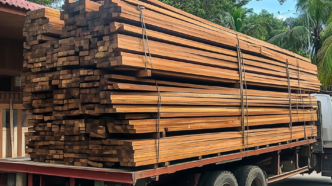What sounds like a sci-fi breakthrough is becoming commercial reality—and it all started in a University of Maryland lab. Back in 2018, materials scientist Liangbing Hu discovered how to transform ordinary timber into a new material that’s stronger than steel. At first, it looked like yet another headline-hyped invention stuck in research limbo. But now, it’s poised to reshape sustainable construction. When Hu first unveiled his discovery, interest poured in—but as a university professor, he wasn’t sure how to take it further. That’s where Alex Lau, now CEO of InventWood, stepped in. Instead of shelving the idea.
Hu kept refining the process, reducing production time from over a week to just a few hours. When the technology was ready, he licensed it to InventWood, a startup dedicated to bringing this innovation to market.
This summer, InventWood will begin commercial production of its first Superwood products, starting with facade applications for commercial and high-end residential buildings. “Right now, we’re focused on skin applications,” Lau said. “Eventually we want to get to the bones of the building.” The company believes replacing steel and concrete in structural elements could dramatically lower construction’s carbon footprint.
How Superwood Is Made—and Why It’s So Strong
At the core of InventWood Superwood is natural timber, made mostly of cellulose and lignin. The goal is to amplify the strength of the cellulose, which on a nano level is already stronger than carbon fiber. Using “food industry” chemicals, the team alters the molecular structure of the wood, then compresses it—boosting the hydrogen bonds between cellulose fibers. That bonding is the real magic.
“We densify the material by four times,” Lau explained, “but it becomes 10 times stronger thanks to these additional bonds.” The final product delivers 50% more tensile strength than steel and a strength-to-weight ratio that’s 10x better, according to the company. It’s also Class A fire rated, resistant to rot, and immune to pest damage.
With added polymer treatments, Superwood becomes stable enough for siding, decking, or roofing. The compression also intensifies natural colors, creating rich hues that resemble tropical hardwoods like walnut or ipe—without any stains or dyes. Future plans include creating structural beams from wood chips that can be customized to any dimension, offering strength, beauty, and sustainability in one product.
To power this leap, InventWood raised $15 million in the first close of its Series A funding. The round was led by the Grantham Foundation, with backing from Baruch Future Ventures, Builders VC, and Muus Climate Partners.
As Lau puts it, “Imagine your I-beams look like this”—holding up a gleaming sample of Superwood—“They’re beautiful. We haven’t stained any of this. These are the natural colors.”
The era of steel-strong, carbon-cutting wood may just be beginning—and InventWood Superwood is leading the charge.













